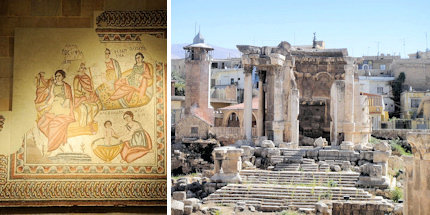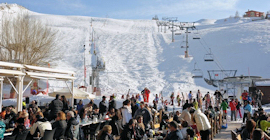Back to Beirut
Beirut may bear the scars of its tumultuous past but the Lebanese capital is on the up again. Gary Noakes returns to the city after 15 years and discovers that you need plenty of stamina to live like a local.
It’s midnight in Beirut’s hip Momo Bar and Tony, a local, is explaining the city’s going out ritual.
First there’s the restaurant, then the ‘before place’, then around 1am, the club, then the ‘after place’, then comes sunrise and the search for street food. The hardcore contingent might then jump in the Land Cruiser and head to the nearby ski slopes. Such is the energy of Lebanon’s capital, whose young population admits to partying like there’s no tomorrow, a hangover from 15 years of civil war fought on a religious divide. That ended in 1992, but the live-for-today mentality remains.
 Downtown Beirut bustles at night
Downtown Beirut bustles at night iStockphoto / Thinkstock
“If I go home early, my parents ask why,” Tony grins, as Beirut’s glitterati – some of them cosmetically enhanced – sip cocktails and gyrate around us to a Europop soundtrack.
Beirut’s image problem means that despite being only four hours from London, its huge appeal as a city break goes almost unnoticed, a shame as nowhere in the Middle East offers the same mix of nightlife and liberal atmosphere with a history dating from the Phoenicians plus astonishingly good skiing only an hour away.
Before the civil war that wrecked Beirut, it was known as the Paris of the Orient, a playground for the Middle East’s rich who went to indulge in pleasures forbidden at home. Now, after a decade of reconstruction and the recent discovery of vast undersea natural gas reserves, it’s on the up again.
Momo, the sister restaurant and bar to the one in London, sits among rows of designer shops near to perhaps the city’s greatest post-war project, the recreation and renovation of Place de l’Étoile. This star-shaped series of streets make up the central district, whose art deco and French colonial buildings could almost be in Paris, were it not for their sandstone construction and the shisha smokers outside the elegant cafés and bars.
See ancient treasures
In this area, another renovation project, St George’s Cathedral, is a reminder of the past in two differing ways. Following successive earthquakes over centuries, Beirut was rebuilt seven times and archaeological layers representing settlement dating back 3,000 years can be seen beneath a glass floor. More poignantly, the meticulously restored Christian wall murals have been left with their gunfire pock marks as a jolting reminder of more recent times.
Overlooking St George’s is the massive blue-domed Mohammed Al-Amin Mosque, finished in 2007. Its construction and the rebuilding of the many Christian churches and other mosques is testament to attempts to break down the divisions that sparked the war. Clearing away the rubble to rebuild was a task similar to that in London after the Blitz, and just as in London some wondrous archaeological discoveries were made.
Fifteen years ago, during my first visit, it was a selfish privilege to stand among the devastation and see these. Some, like the Roman Baths discovered before the conflict, remain uncovered, but tragically, others were buried or destroyed in the frenzied pace of reconstruction. Treasures that were salvaged during this process and those discovered in earlier, perhaps less mercenary times, can be seen at the National Museum. Here, the fabulous collection ranges from coloured Roman glass oil bottles that have somehow survived the centuries to mosaics and huge Phoenician sarcophagi. The latter were encased in cement to protect them during the fighting.
 A relic at the National Museum and ancient architecture
A relic at the National Museum and ancient architecture WTG / Gary Noakes and iStockphoto / Thinkstock
After a day’s immersion in dusty history, you can dress to impress and join those keen to be seen at the palatial Phoenicia Hotel. Even here you are not immune from recent events. During the war, the property, at one end of the Corniche overlooking the bay, was a hideout for snipers and militia using rocket launchers and was ruined. Behind it is the Holiday Inn, which remains a shell. The debate continues over whether to restore it, or, like Berlin’s Kaiser Wilhelm Church, keep it as a peace symbol.
Today, The Phoenicia is the place for society weddings, and its weekly food events, open to non-residents, are justly famous. Wherever you eat, dining in Beirut is a glorious fusion of Arabic, Mediterranean and French. Expect to eat pain au chocolat for breakfast, houmous and tabouleh for lunch and fresh fish for dinner. Upscale hotels like Le Vendome, a boutique property overlooking the bay, attract residencies from chefs from around the world, such as, during my visit, a French fromagier.
Head for the slopes
Working off all that cheese meant hitting the ski slopes overlooking the city at Mzaar. This is Lebanon’s biggest and best resort and – while it attracts its fair share of poseurs who don the latest designer gear, ski for an hour and then sip cocktails on the terrace of the InterContinental for the remainder of the day – don’t be fooled, this is serious stuff.
 A snowy escape from the city
A snowy escape from the city WTG / Gary Noakes
Mzaar, with 80km (50 miles) of pistes, might be small by European standards, but it reaches to almost 2,500m (8,000ft). The sprawling expanse, combined with the sometimes leisurely-paced lifts means you will struggle to do all the runs in a day and two days are advisable. The natural open bowls mean numerous off-piste opportunities and good skiers will not be disappointed with the taxing black runs.
Moreover, the views are spectacular – on a clear day you can see Cyprus in one direction and Baalbeck, the crossroads of an ancient trading route and site of some of the world’s most impressive Roman temples, in the other.
Back in the city, after a drive past terraces of apple trees and yet more Roman remains, the sun is dimming on the Corniche’s 8km (4-mile) stretch of waterfront. As some sip beers and fortified Lebanese coffees, the call to prayer from the waterside mosque goes out. Nearby, a micro-skirted woman attracts a friendly ‘Lady Gaga!’ comment from an admirer as she strolls amid the fishermen, balloon sellers and families pushing buggies.
I’m reminded of my earlier conversation with Tony, who told me that Beirut’s young population would not allow it to return to how things were. This is a city that has learned, albeit the hard way, to live with itself and is making up for lost time.
How to get there: Middle East Airlines and British Airways fly daily to Beirut from London Heathrow Airport.
Where to Stay: The Phoenicia (Rue Fakhreddine; tel: (1) 369 100) offers rooms from $275, including breakfast. Le Vendome (Rafic El Hariri; tel: (1) 369 280) has rooms from $300, including breakfast. A free ski shuttle is provided for guests.
Do you have any Feedback about this page?
© 2025 Columbus Travel Media Ltd. All rights reserved. No part of this site may be reproduced without our written permission, click here for information on Columbus Content Solutions.









 You know where
You know where